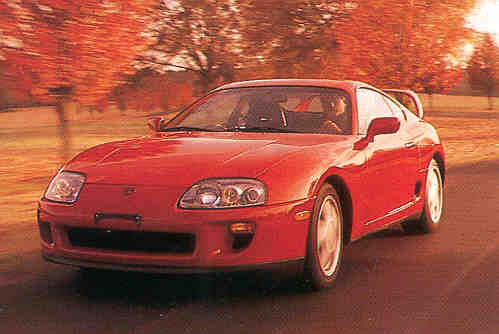
| Wheels Magazine |
|---|
| Godzilla Killer |
This is Juan Manuel Fangio II's first drive of Toyota's all-new 239 kW twin turbo Supra. It's also his first time on the daunting high banks of the Atlanta Motor Speedway oval. I try to calm my passenger-seat nerves with the knowledge that the nephew of the legendary Argentinian racer is no stranger to race tracks or high-powered sports cars. After all, the younger Juan captured the 1992 IMSA driver's championship in Toyota's 500 kW GTP racer, no mean feat considering the opposition from Jaguar and Nissan. Despite Juan's casual confidence, my stomach tightens as we rocket round the turns of the 2.4 km oval. A glance at the speedometer reveals our speed is closing in on 240 km/h. At such a pace on the so-called straight, I would be slowing to deal with the wall of death corner that approaches. But not Juan. He keeps his foot down, the car's suspension compresses, touching its bump stops briefly, and then we're through and moving even faster towards the next turn. The Toyota engineers are allowing just two flying laps at a time before the car comes into the pits to check the temperature and condition of the Supra's Bridgestone tyres. It's a sensible precaution, because despite being some of the best tyres available, the big Potenzas are not supposed to endure this kind of abuse. Now it's my turn behind the wheel. I accelerate hard down pit lane with the thought that these banked tracks do not take kindly to dawdlers. Ovals like Atlanta Motor Speedway are usually home to NASCAR racers, with their hulking silhouette sedans drafting each other, bumper to bumper at 320 km/h. 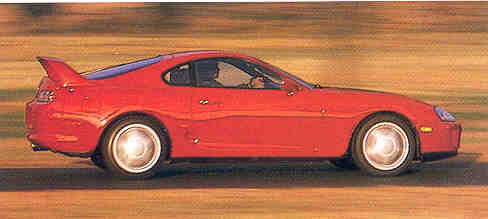
Getting up to speed through the Supra's new six speed gearbox is no problem; the sequential twin turbos turn the Toyota's 3.0 litre dohc straight six into a muscle car motor, bursting with 239 kW and 427 Nm of torque. That, claims Toyota, translates into a 5.2 second 0 - 100 km/h time, a 13.5 second 400 metres and a potential top speed of more than 280 km/h, although the car is electronically limited to 250 km/h. We're talking Godzilla-killing times here. Wheels' best results from the Nissan GT-R's test times were two-tenths of a second slower in both brackets. Before I know it, I'm looking at 225 km/h and one of those 'Oh my god' turns is looming. Not wishing to be the first scribbler to deposit the Supra's bright red paint on the walls of the banking, I back off a little. Rounding the turns I realise that my discretionary move was uncalled for; the Supra's suspension - double wishbones front and rear - scoffs at the high cornering loads. Stability, it seems, is the new Supra's middle name. The car's rear-drive chassis is much stiffer than the old Supra's, despite being 140 kg lighter. Even in the toughest, bumpiest parts of the Speedway, where the stresses on the car are most intense, the Supra feels rock solid. Not so with the rival cars Toyota brought to the party. A top line Dodge Stealth (aka Mitsubishi 3000GT), replete with 223 kW, four-wheel drive and four-wheel steering, makes a good showing, but the steering is jolted by the mid-corner bumps, unlike the finely damped Supra set-up, and during the turns the stealth chassis is disturbed by the rough track while the Toyota remains unfazed. 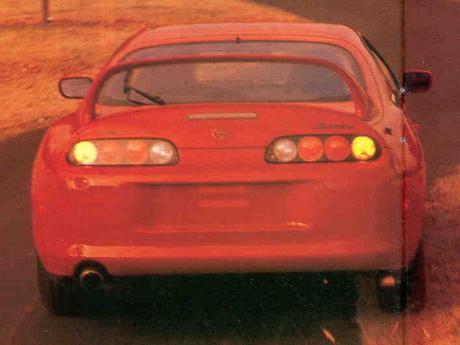
Next up is an RX-7, one of the brightest new stars in the sports car world. But impressive thou the Mazda is in many areas, it feels out of its depth in the company of the Supra. Fangio sums up the RX-7s behaviour: "it doesn't feel quite as secure," he says. "if something went, the back would go before the front. The Supra gives you more confidence." Even though Fangio's opinions may be a trifle biased, bearing in mind his Toyota commitments, the RX-7 does feel nervous, where the Supra projects balance and security. While on the subject of comparisons, there's the matter of performance to be considered. The flow of torque from the turbo Supra is so strong it feels more like a big American V8 than a blown six. There's a telling difference in mid-range acceleration compared with the 3000GT twin turbo, which is heavier than the 1565 kg Supra turbo. Interestingly, the considerably lighter RX-7, at 1270 kg, has nearly the same power to weight ratio as the Toyota. But while the Mazda feels exceptionally quick on its feet, it cannot match the sheer grunt of the Supra's power delivery. What's needed (and sorely missed) for this mini comparison is the Nissan GT-R. Of course, Godzilla only made it to the Japanese and Australian markets, but given Toyota's claimed acceleration times for the Supra, it would be interesting to compare the two hottest Japanese supercars back to back. The Supra's 24 valve six really gets into its stride at around 3500 rpm, at which point it produces a seemingly boundless surge of energy, rather like a Porsche 911 Turbo in full song. Considering the power levels being handled, the Supra's gearbox is surprisingly light and flickable. The throws are short and matched in effort by the clutch pedal. Add a set of well modulated, powerful brakes, which feature unusual spiral ventilation cooling fins and four channel ABS, and you have a very controllable sports car. This much becomes clear when I take the Supra onto the Atlanta Speedway's four kilometre road course which combines part of the oval with a twisting, tricky infield track. 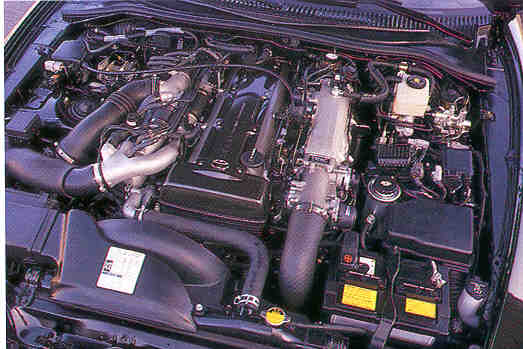
Driving with the electronic traction control system switched off, the Supra's substantial torque will break the rear end loose on demand, but the car can be caught easily, even when the tail is well out. This trait echoes a statement from one of the hotshot Japanese test drivers who says the Supra was "designed to be stable with the emphasis on oversteer". If there is a criticism to be levelled at the car's dynamics, it concerns the steering, which needs to provide a tad more feedback at the wheel. While the new Supra's performance and handling put it firmly in contention with its leading Japanese and European rivals, the car's design - inside and out - is not nearly as successful. There is an odd lack of coherence in the new design; the glasshouse is unfashionably small for such a wide-bodied car, now three inches broader at the hips. And the Japanese design team appear to have been gazing at too many pictures of Ferrari F40s to judge by the obviously derivative rear wing, large nose air intakes and no less than eight round tail-lights. The high-wing rear spoiler is actually optional on the turbo model and bumps the Supra's drag coefficient up a point to 0.33, but without it the car's rump looks too heavy. The Supra designers wanted to keep things simple inside the car - the opposite approach, they say, to the gimmick-laden Mitsubishi 3000GT cockpit. The intention was honourable, but the result is a flat and featureless instrument panel that appears too large and spartan. The expanse of black plastic on the dashboard coupled with black leather seating trim creates a gloomy atmosphere in the high-waisted interior. Quite where the '93 Supra turbo falls in the sports car spectrum remains to be seen; its speed and chassis competence promise to give the current front runners a very hard time. Toyota's new flagship performance car is faster and more comfortable than the entertaining but unforgiving RX-7, but not as stylish or sophisticated as Honda's NSX. As such the Supra deserves to be taken seriously, although there's no guarantee it will find a place in the fickle hearts of sports car buyers. 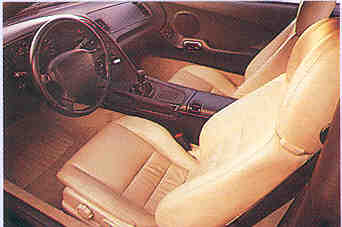
According to Isao Tsuziki, chief engineer of the 1993 Supra, the objective for the car was to have " the power of a Corvette ZR1 with the refinement of a Honda NSX". TSuziki's engineering team, including a group of test drivers he calls Toyota's "top guns", toured the world during the Supra's development, visiting tracks like the Nurburgring and Silverstone, and assessing all the car's potential rivals. They included the Porsche 911 Carrera, the 928, which was the benchmark for high speed stability, and the 944 Turbo, which at the time was Tsuzuki's target for yaw and pitch stability. Later in the program the NSX appeared and became the target for ease of driveability and smoothness at high speed. "Were satisfied that the Supra exceeds the NSX in these areas, and is better than the NSX in terms of sudden rear end breakaway", says Tsuzuki. Tsuziki's plan with the Supra was to cut down on weight whenever possible and avoid "unnecessary technology like four-wheel steering". The Supra's impressive 140kg weight reduction over its predecessor was accomplished despite the addition of a standard passenger side airbag, bigger brakes and larger wheels and tyres. Among the kilo saving measures, were a single, rather than a dual exhaust, the elimination of the adjustable damper system, an aluminium bonnet, plastic fuel tanks and even hollowed out boltheads. Before deciding on the new Supra's engine, Tsuzuki considered all the alternatives, but says the in-line six won out because of its light weight and the ability to package the twin turbos. Although Europe will only see the turbo version, a normally aspirated 164kw Supra, with a 5 speed gearbox, will be sold in the US. The non-turbo motor is shared with the Lexus GS300 sedan and produces almost as much power as the outgoing Supra turbo.
The new Supras go on sale in America in June, and will reach other world markets
(but unfortunately not Australia) later this year. |
| Specifications | |
|---|---|
| Engine | In-line 6 |
| Type | dohc, 24 valves, twin turbo |
| Bore x Stroke(mm) | 86.0 x 86.0 |
| Capacity(cc) | 2997 |
| Compression Ratio(:1) | 8.5 |
| Power:KW @ rpm | 239 @ 5600 |
| Torque:Nm @ rpm | 427 @ 4000 |
| Measurements | mm |
| Wheelbase | 2550 |
| Length | 4514 |
| Width | 1811 |
| Height | 1275 |
| Track-front/rear | 1521/1527 |
| Kerb Mass(kg) | 1565 |
| Fuel Tank(l) | 70 |
| Suspension | Independent |
| Suspension - front | double wishbones, coil springs, anti-roll bar |
| Suspension - rear | double wishbones, coil springs, anti-roll bar |
| Transmission | 6 Speed manual |
| First | 3.828 |
| Second | 2.360 |
| Third | 1.686 |
| Fourth | 1.312 |
| Fifth | 1.000 |
| Sixth | 0.794 |
| Final Drive | 3.266 |
| Steering | speed sensing |
| Type | rack & pinion |
| Turns lock to lock | 3.0 |
| Brakes | power assisted |
| Tyep | vented disks, ABS |
| Tyres - make | Bridgestone Potenza |
| Tyres - front | 235/45 ZR17 |
| Tyres - rear | 255/40 ZR17 |
| Performance | manufacturers claims |
| 0 - 100 km/h (62mph) | 5.2 |
| 0 - 400m | 13.5 |
| Top Speed | 250 km/h (limited) |
Back to Home Page
Last modified on Monday, April 24, 2000